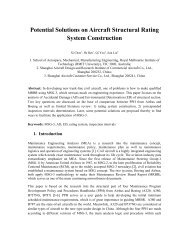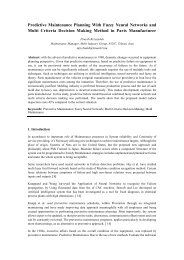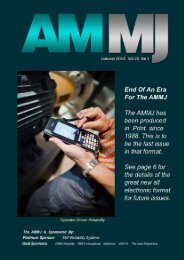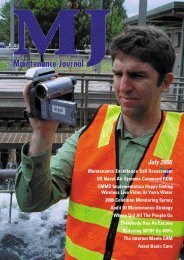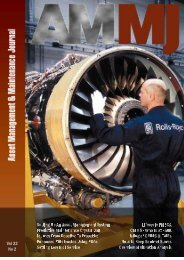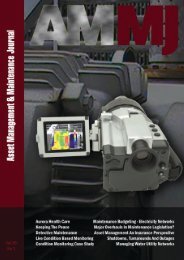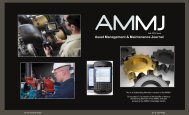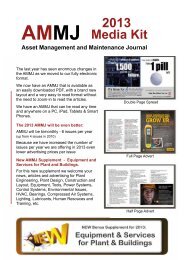July - AMMJ
July - AMMJ
July - AMMJ
You also want an ePaper? Increase the reach of your titles
YUMPU automatically turns print PDFs into web optimized ePapers that Google loves.
51<br />
MAINTENANCE STRATEGY<br />
SERIES<br />
Terry Wireman<br />
21.1 Preventive Maintenance (Vol 1)<br />
2007 220pp $90<br />
The first volume in this series, Preventive<br />
Maintenance, begins by detailing the importance of<br />
preventive maintenance to an overall maintenance<br />
strategy. The text clearly illustrates how the<br />
components of any maintenance strategy are<br />
interlinked with dependencies and the performance<br />
measures necessary to properly manage the preventive maintenance<br />
program. A process flow diagram details the steps of developing<br />
the preventive maintenance program, and the appendixes contain<br />
numerous examples of preventive maintenance inspections for the<br />
reader to begin applying to their program immediately.<br />
• Shows how to tactically develop a preventive maintenance program,<br />
answering questions, such as “What equipment to include?, What skill<br />
level of the technicians are required?, How to actually perform basic<br />
PM tasks?”, and many others.<br />
• Does not over-emphasize the value of preventive maintenance to<br />
the exclusion of other components of a maintenance strategy.<br />
21.2 MRO Inventory & Purchasing (Vol 2)<br />
2007 150pp $90<br />
The second volume in the series, Inventory and<br />
Purchasing, shows the reader how to develop<br />
an inventory and purchasing program for<br />
MRO spares and supplies as part of an overall<br />
strategy. Specifically, the text focuses on the<br />
importance of a well organized storage location<br />
and part inventory numbering system detailing<br />
to the reader the most effective ways to accomplish this goal.<br />
The receiving and parts issues disciplines are discussed in detail<br />
with a focus on the value proposition for spare parts controls and<br />
justification of storeroom overhead. In addition, the appendixes<br />
provide examples of parts and detail storage conditions that<br />
can be utilized in developing or refining an inventory storage<br />
location.<br />
21.3 Maintenance Work Management Processes (Vol 3)<br />
2007 200pp $90<br />
Work Management Processes, focuses on developing a work<br />
management process that will support the maintenance strategy<br />
components. It outlines a financially cost effective process that<br />
collects the data to use advanced strategies such as RCM and<br />
TPM. The text extensively details the maintenance organizational<br />
development process and then outlines nine basic work management<br />
flows. The nine flows are then detailed and the potential problems<br />
with executing the flows are examined along with solutions to the<br />
most common problems.<br />
• The Business of Maintenance<br />
• Work Identification Process<br />
• Emergency – Breakdown Work Process<br />
• Work Request Process<br />
• The Simple Planning Process<br />
• The Complex Planning Process<br />
• The Preventive Maintenance Process<br />
• Project Planning Process<br />
• The Weekly Scheduling Process<br />
• The Work Closure and Analysis Process<br />
21.4 Successfully Utilizing CMMS/EAM Systems (Vol 4)<br />
2008 238pp $90<br />
Shows how CMMS/EAM systems are necessary to support a<br />
maintenance and reliability organization in companies today. The<br />
proper methodologies for selecting and implementing a CMMS/EAM<br />
system. How to properly utilize the system to gain a maximum return<br />
on the system investment.The organization and methodology to truly<br />
achieve Enterprise Asset Management - an elusive goal for most<br />
organizations.<br />
Contents:<br />
• Introduction to CMMS/EAM<br />
• Maintenance Strategy Assessment<br />
• CMMS/EAM Systems<br />
• The Selection Process<br />
• The CMMS/EAM System Implementation Process<br />
• Utilization of the CMMS/EAM System<br />
• CMMS/EAM System Optimization<br />
• Return on Investment<br />
• The Future of CMMS/EAM Systems<br />
• Performance Indicators for CMMS/EAM Systems<br />
22. Facility Manager’s Maintenance<br />
Handbook 2 ND Edition<br />
B. Lewis and R Payant<br />
2007 560pp $240<br />
An essential on-the-job resource, Facility Manager’s<br />
Maintenance Handbook presents step-by-step<br />
coverage of the planning, design, and execution<br />
of operations and maintenance procedures for<br />
structures, equipment, and systems in any type of<br />
facility.<br />
This career-building reference provides the tools needed to streamline<br />
facility management processes?reduce operational costs?and ensure<br />
the effective utilization, maintenance, repair, and renovation of existing<br />
physical assets.<br />
Now with 40% new information, this Second Edition includes brand-new<br />
chapters on emergency response procedures, maintenance operations<br />
benchmarking,capital and operational budgets management, boiler<br />
and steam plant operations... and other vital topics.<br />
The only book of its kind to cover both operations and maintenance,<br />
the updated Facility Manager’s Maintenance Handbook features:<br />
• Updated information on mechanical equipment and systems<br />
maintenance<br />
• The latest fire protection procedures<br />
• A comprehensive account of building codes<br />
• Guidance on hazardous materials handling<br />
• Excellent preparation for the IFMA Certified Facility Manager (CFM)<br />
qualification<br />
23. Maintenance Planning &<br />
Scheduling Handbook 2nd Ed<br />
Richard D Palmer<br />
2006 544pp $180<br />
Many readers already regard the Maintenance<br />
Planning and Scheduling Handbook as the chief<br />
authority for establishing effective maintenance<br />
planning and scheduling in the real world. The<br />
second edition adds new sections and further<br />
develops many existing discussions to make the<br />
handbook more comprehensive and helpful.<br />
In addition to practical observations and tips on such topics as creating<br />
a weekly schedule, staging parts and tools, and daily scheduling, this<br />
second edition features a greatly expanded CMMS appendix which<br />
includes discussion of critical cautions for implementation, patches,<br />
major upgrades, testing, training, and interfaces with other company<br />
software. Readers will also find a timely appendix devoted to judging<br />
the potential benefits and risks of outsourcing plant work. A new<br />
appendix provides guidance on the “people side” of maintenance<br />
planning and work execution.<br />
The second edition also has added a detailed aids and barriers<br />
analysis that improves the appendix on setting up a planning group.<br />
The new edition also features “cause maps” illustrating problems with<br />
a priority systems and schedule compliance. These improvements<br />
and more continue to make the Maintenance Planning and Scheduling<br />
Handbook a maintenance classic.<br />
Vol 24 No 3




